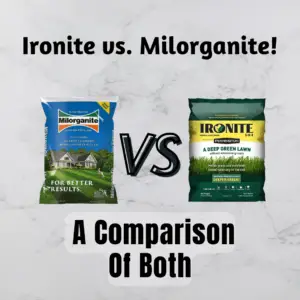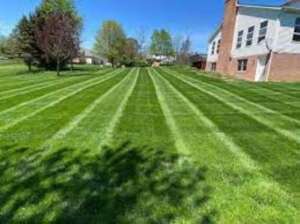Table of Contents

Healthy grass will be a rich, dark green. Despite the abundance of common sense solutions, a healthy lawn needs more than just water and sunlight. To have a healthier and greener lawn, many homeowners choose to use lawn products like Milorganite or Ironite. While both treatments include iron, helping properties get more beneficial and more innocent, they do it in distinct ways and with specialized formulas and ingredients.
This article will help you to help you finalize which product is best for your garden, by comparing Milorganite with Ironite.
So let’s get start!
Milorganite
Milorganite is a nutrient-rich fertilizer made from wastewater that contains organic nitrogen. Milorganite is produced by the Milwaukee Metropolitan Sewer District, which processes wastewater by allowing bacteria to extract nutrients. These bacteria are subsequently kiln-heated to produce an organic, granular fertilizer safe to use on your lawn. Milorganite has an N: P: K ratio of 6:4:0. This signifies that the product has a high nitrogen and appropriate phosphorus content.
Nitrogen, as you may know, promotes robust top growth, whereas phosphorus is critical for strong root development. Milorganite has high nitrogen content. Thus it also contains other minerals, including about 2.5% iron. Besides being an organic fertilizer, one of the main benefits of Milorganite is that it may be manufactured in a slow-release form. This implies that it will continue to nourish your grass for a very long time. Your lawn should receive nourishment from each application for about ten weeks.
When To Use Milorganite?
Using milorganite on cool-season grasses like fescue and bluegrass is recommended annually. It is suggested for usage when the temperature is continuously higher than 6 degrees Fahrenheit and the grass has a healthy green hue and vigorously developing.
Treatments for these types of grass can be applied late in the year. This will keep your lawn in good condition over the winter while the grass is dormant. Treat warm-season grasses in late spring when temperature exceed 70 degree for the best results, and continues until early fall. Don’t undertake your final fall feeding of lawn care until after Halloween, as this green grass kind is sensitive to late feeding.
Ironite
Its primary use is as a supplement for adding green to your grass, as ironite is a rich source of the element. Their ratio of nitrogen to phosphorus to potassium is exactly 1:1. Ironite, as may be seen, has relatively low nitrogen content and high iron content (around 20%).

Ironite does not contain any nutrients. However, the iron it does prevent will make the grass greener. Moreover, it works rapidly; you may expect to notice effects in just a few days. Grass that has begun to turn yellow may suffer from an iron deficit. This is when taking an Ironite supplement would be most beneficial.
What Role Does Ironite Play In Making Your Grass Greener?
Chlorophyll production in plants relies on the element iron. Plants get their green hue from a pigment called chlorophyll, which is also essential for photosynthesis.
Ironite facilitates oxygen transfer from the plant’s roots to its leaves. This aids the plant in producing chlorophyll, the pigment responsible for its characteristic green hue. This applies to any vegetation, including grasses used for landscaping. If your grass is becoming yellow despite adequate irrigation, it likely has an iron shortage.
Why And When To Use Ironite?
You can use either liquid Ironite or granular Ironite in conjunction with your usual fertilizer applications or as needed. Ironite should be applied no more than ten times per year and no less than 4 times every year with your regular feeding plan. A soil test before and after applying liquid Ironite is an excellent idea to ensure you are not overdosing and damaging the soil.
Comparison of Ironite and Milorganite
The distinctions between Ironite and Milorganite are below:
Ironite |
Milorganite |
|
|
|
|
|
|
|
|
|
|
|
|
|
Drawbacks of Ironite on Lawns

Ironite has the potential to permanently discolour concrete, even pathways if the two come into contact.
This is not the best option for those who prefer to keep things natural. It’s easy to go overboard, which puts lawns at risk for damage and a greyish hue.
It has been identified as a source of metal leakage, particularly lead and arsenic, even though this fertiliser is considered safe for use in the house.
Drawbacks of Milorganite on Lawns

When compared to synthetic fertilisers and nutrient supplements, milorganite does not provide an instant improvement in growth and colour. To get a lush, dark green lawn quickly, milorganite is not the way to go.
Final Thoughts
This article presented a comparison of Ironite vs. Milorganite. It also includes the brief introduction of both, information about when and how to use these fertilizers and their drawbacks on lawns. If you are planning to use these fertilizers, Ironite and malorganite in your lawn, then this article will answer all of your questions related to the purpose of their use and the results after use.Hope you will enjoy the reading!
